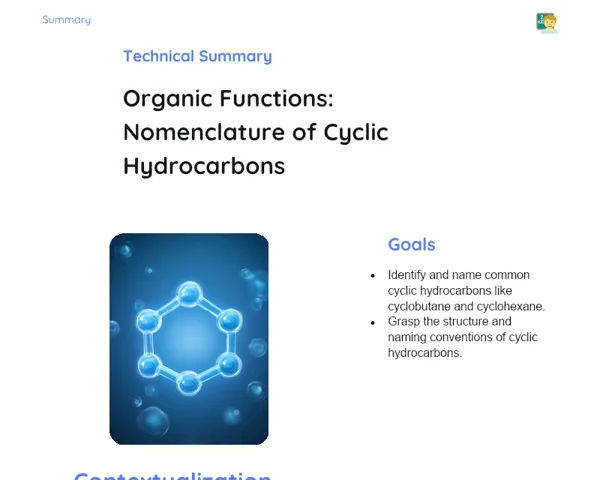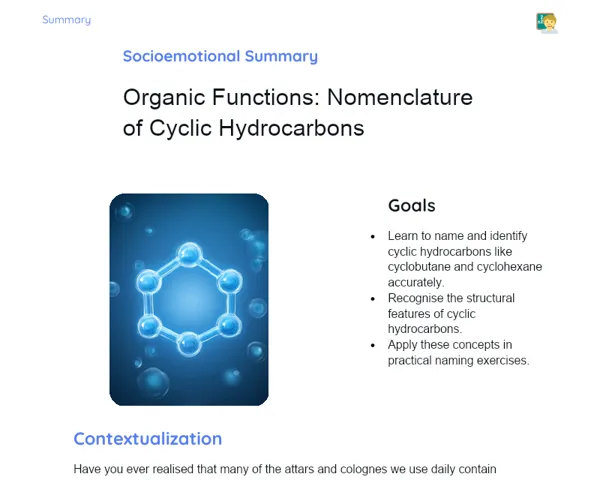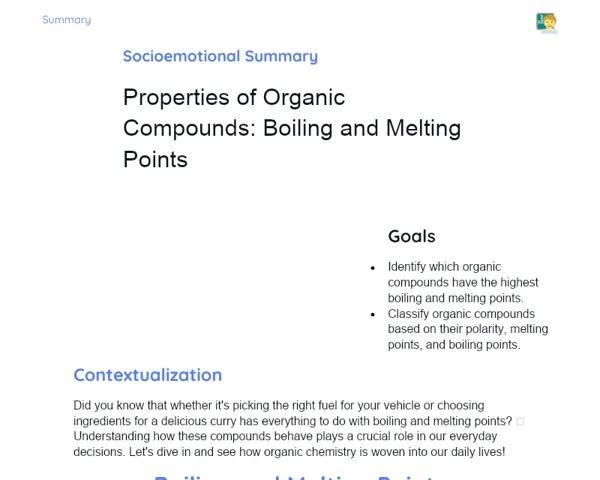Summary Tradisional | Electrochemistry: Faraday's Laws
Contextualization
Electrochemistry is an important branch of chemistry that explores the intricate relationships between chemical reactions and electricity. One of the key processes in this realm is electrolysis, where an electric current is passed through a solution to trigger non-spontaneous chemical reactions. This technique has numerous industrial applications, ranging from the production of metals like aluminum and copper to the manufacture of essential chemicals such as chlorine and caustic soda.
The laws of Faraday play a pivotal role in understanding the principles that govern electrolysis. Formulated by the renowned scientist Michael Faraday in the 19th century, these laws quantitatively describe how the amount of substance deposited or released at an electrode correlates directly with the electric charge flowing through the solution. Mastering these laws is vital for carrying out precise calculations in various industrial processes, such as electroplating, which involves coating metals with another metal to enhance durability and aesthetic appeal.
To Remember!
First Law of Faraday
The First Law of Faraday posits that the amount of substance (m) deposited or released at an electrode is directly proportional to the amount of electric charge (Q) that passes through the solution. The fundamental relationship can be expressed with the formula m = kQ, where k is the proportionality constant. This constant is specific to the type of substance and depends on various conditions, such as temperature and concentration.
In practical terms, this law empowers us to calculate the mass of a specific material that gets deposited during electrolysis, based on the electric charge applied. This is particularly crucial in industries such as electroplating and electrowinning.
Comprehending the First Law of Faraday is vital for executing industrial processes accurately and efficiently, ensuring that the material deposited meets the required quality and quantity standards. Proper application of this law helps optimize resources and minimize waste.
-
The amount of substance deposited is directly proportional to the electric charge.
-
Formula: m = kQ, where k is a proportionality constant.
-
Practical applications in industries, particularly in electroplating and electrowinning.
Second Law of Faraday
The Second Law of Faraday builds on the First Law by stating that the mass of different substances deposited or released by an equal amount of electricity is proportional to their chemical equivalents. This law can be expressed with the formula m = (M/F) * (Q/z), where M is the molar mass of the substance, F is the Faraday constant (approximately 96485 C/mol), Q is the electric charge, and z is the number of electrons participating in the reaction.
This law highlights the varying responses of different substances to the same electric current. For example, when identical electric charges are passed through solutions of copper and silver, the mass of copper deposited will be different from that of silver, governed by their chemical equivalents.
The Second Law of Faraday is particularly beneficial in processes involving multiple substances, enabling accurate calculations for the mass of each substance that will be deposited or released, which is key for the effectiveness and quality of industrial electrolysis.
-
The mass of various substances deposited is proportional to their chemical equivalents.
-
Formula: m = (M/F) * (Q/z), with M as molar mass, F as Faraday constant, Q as electric charge, and z as the number of electrons.
-
Crucial for calculations in electrolysis processes involving multiple substances.
Calculating Electric Charge (Q)
A solid grasp of calculating electric charge (Q) is essential for the proper application of Faraday's Laws. Electric charge signifies the amount of electricity that flows through a circuit and can be calculated using the formula Q = I * t, where I is the electric current in amperes (A) and t is the time, measured in seconds (s).
This calculation is fundamental because the amount of electric charge directly influences how much substance will be deposited or released during electrolysis, as per Faraday's Laws. Therefore, knowing the current applied and the duration of the electrolysis allows for precise predictions of the mass of material processed.
Being adept at calculating electric charge is crucial for effective planning and implementation of industrial electrolysis processes, ensuring operational conditions are aptly set to achieve the desired outcomes. Additionally, it allows for timely and precise adjustments when necessary, maintaining efficiency and quality in processes.
-
Electric charge calculation: Q = I * t, where I is current in amperes and t is time in seconds.
-
Electric charge determines the quantity of substance deposited or released.
-
Essential for thorough planning and execution of electrolysis procedures.
Practical Examples
Bringing Faraday's Laws to life through practical examples is a fantastic way to reinforce theoretical understanding and demonstrate how concepts apply in real-world situations. For instance, calculating the mass of copper deposited on an electrode when a 2A current is passed through a CuSO₄ solution for 30 minutes requires using the formula Q = I * t to find the electric charge and then employing the Second Law of Faraday to determine the amount deposited.
These practical examples are vital for students to grasp how the formulas and concepts previously discussed in class are directly applicable. Solving real scenarios enables visualisation of how theoretical calculations yield tangible results, which is fundamental for a comprehensive understanding of the electrolysis process.
Furthermore, working through practical examples is beneficial for exam preparation, as the ability to apply theoretical concepts to specific problems is often tested. This experience not only boosts students' confidence in their problem-solving abilities but also equips them for future challenges in both academic and industrial environments.
-
Practical examples enhance theoretical understanding.
-
Help visualize theoretical calculations applied in actual circumstances.
-
Critical for exam preparation and addressing problems in industrial contexts.
Key Terms
-
Electrochemistry: The study of relationships between chemical reactions and electricity.
-
Electrolysis: A process using electric current to invoke non-spontaneous chemical reactions.
-
Faraday's Laws: Principles quantitatively describing the relationship between the substance deposited or released and the electric charge passing through the solution.
-
Faraday Constant (F): An approximate value of 96485 C/mol utilized in Faraday's laws formulas.
-
Chemical Equivalent: The proportion of a substance's mass to the electric charge required for its deposit or release.
-
Electric Current (I): The flow of electric charge measured in amperes (A).
-
Electric Charge (Q): The amount of electricity flowing through a circuit, calculated by Q = I * t.
-
Electrolysis Time (t): The period during which the electric current is utilized in an electrolysis process.
Important Conclusions
The laws of Faraday are crucial for comprehending the principles that govern electrolysis, facilitating precise calculations regarding the amount of substance deposited or released at an electrode. The First Law of Faraday sets forth the direct relationship between electric charge and the quantity of substance deposited, while the Second Law elucidates how various substances react to identical currents based on their chemical equivalents.
Grasping electric charge calculations is vital for the accurate application of Faraday's Laws. The formulation Q = I * t aids in determining the electric charge based on current and electrolysis time, which is essential for predicting the mass of material processed. Using practical examples enriches theoretical understanding and demonstrates the real-world application of concepts.
The domain of electrochemistry and Faraday's laws holds significant value across diverse industries, from metal production to chemical manufacturing. Mastering these principles not only optimizes the efficiency and precision of industrial processes but also opens up avenues for technological innovations and sustainable practices, such as hydrogen production and electroplating.
Study Tips
-
Revise practical examples discussed in class and attempt additional problems to reinforce your understanding of Faraday's laws.
-
Familiarize yourself with the mathematical formulas linked to Faraday's laws, paying attention to each variable and their interrelationships.
-
Investigate real-world applications of electrolysis in industries, like metal production and electroplating, to appreciate the significance of the topic.



